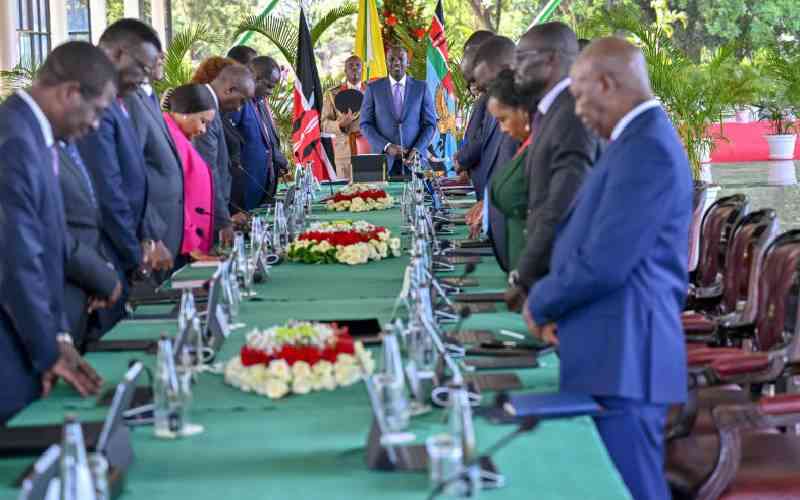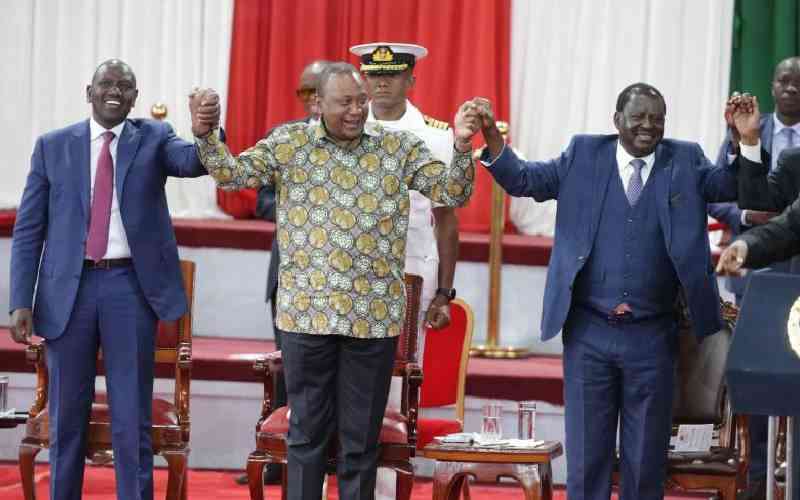
The demands on the Ruto Cabinet by Gen Z protesters have left the president between the proverbial rock and the hard place. This generation and other Kenyans, among them the political Opposition and segments of the faiths based community, have asked the president to sack his entire Cabinet.
The protesters are demanding that a brand new team be appointed, from among competent and unsullied persons. Segments of the Ruto Cabinet have attracted public disgust, due to perceptions of grand corruption. Also in the mix are grandiose displays of lavish lifestyles, at the expense of an overtaxed public that survives from hand to mouth. Media headline news on Friday spoke of anxiety in the Cabinet. Ministers were worried about the possibility of the entire team being sent packing. That is with the exception of the Deputy President, Rigathi Gachagua, who is part of the Presidency. But the Cabinet earthquake had not happened, at the time of this writing.
The much anticipated presidential bombshell did not detonate, perhaps because Ruto has no such intent. Instead, the president announced a raft of sedative measures, some of which have featured on the on the Gen Z catalogue of ultimatums, during two weeks of intense anti-government protests in which 41 people have been killed. Apart from the disgraced Finance Bill that sparked the protests, Kenyan Gen Z and Millennials have handed the Ruto government a 14-point grievance and demand schedule. Prominent among the demands is dissolution of the Cabinet.
It is not an easy assignment for the president. The choice before him is between trying to secure his current term, by caving in to popular demands; or ignoring the public and, thereby, exposing his presidency to continued turbulence, out of popular grievance and mistrust. Dismissing his Cabinet is, nonetheless, also rife with risks. It will, above all, eat into Ruto’s dream of a second presidential term. For, the Cabinet has some of his ardent political lieutenants and vote hunters. If he sacks them, they will go with whatever individual public goodwill they promise to bring to Ruto’s political table.
Yet, Ruto must choose between saving a badly tainted and troubled presidential first term, and pawning public goodwill and patience in his first term with pursuit of an uncertain future second term. It is possible that if he is perceived to be embracing reforms, the ubiquitous outrage against him could drop, somewhat. If he does not embrace genuine reforms, however, he must fasten his political safety belt for a turbulent ride through what is left of the current term. He must also reckon with what begins looking like the promise of a thorough drubbing in 2027.
And yet even reforms do not guarantee Ruto popular support and victory in 2027, on account of the heavy dose of mistrust he has earned among Kenyans. The president is one person with readymade stock answers for everything. He fires straightaway at any question put to him. There are no external facial signs or bodily indications of deep reflection informing anything he says. His articulation of issues and verbal promissory notes, put together with gross failure to deliver, have led to what a panel of interviewers in the ended week referred to as “the public not associating the truth with President Ruto.”
It will remain difficult for Kenyans to trust that President Ruto can be good for them in a secure second term, having been reluctant to do what they have wanted of him in a precarious first term. Kenyans are especially incensed by unprecedented economic hardship, contrary to the heavenly electoral promises that Ruto and his team made before they came to power. They want to see the president drawing political blood at Cabinet level, as an essential minimum of hope that he could be trusted.
To sack his Cabinet now, as is being demanded of him, or saving it and waiting with closed eyes for 2027 are, therefore, Ruto’s two choices. If he keeps the Cabinet, he must hope that it will reform itself. It must also help him to overcome the current crises, to survive to 2027, and beyond. The president must know, however, from the widespread public outcry against this team that it is a very unpopular assembly of men and women. He, therefore, throws his weight behind it at his own risk, and peril.
Second chance
On the flipside, by asking the president to appoint a new Cabinet, Kenyans are telling the president that they are willing to give him a second chance in what remains of this term. In spite of the protests, they are essentially willing to help him navigate the country to 2027. They will then decide what to do with him. The focus here is on the need for a stable country.
It is instructive that the president’s own Kenya Kwanza senators have been at the forefront of the call for a new Cabinet. Sounding more like a member of the political Opposition, the Majority Leader in the Senate, Aaron Cheruiyot, wondered how an astute Cabinet could focus on playing politics instead of the work the president has appointed it to do. Majority Whip and Kakamega Senator Boni Khalwale, lamented about “ineptitude, corruption and arrogant display of ill-gotten wealth in the Cabinet.” Khalwale told the Senate, “Cabinet Secretaries are very corrupt and are not ashamed to show off to Kenyans who are hungry.”
The Senate’s closing of political ranks on Cabinet is a mortal warning to President Ruto. The legislature is responding to the public mood. A few MPs from the National Assembly have already tasted the wrath of the people by being shouted down and chased from public gatherings after the Finance Bill. Parliament will walk the tightrope for the rest of the term. Few MPs, if any, will want to be on the wrong side of the public.
Ruto must weigh the public mood on the scales of political self-preservation, against loyalty to political friends. Loyalty to Cabinet cronies could prove to be a political death wish. Kenyans are unhappy with this Cabinet not just because it approved the disgraced Finance Bill before taking it to Parliament. Corruption and wastefulness is the problem. Worse is that State House seems unable to do anything about it, and often appears keen to sanction the status quo. In his Friday statement on reforms, President Ruto was deathly silent on corruption and wastage.
Kenyans are angry at corruption, wastage and show of opulence by ministers and other public officials, who have become filthily rich in less than 24 months. Stories are told of persons who would previously call their friends seeking a share of as little as ten thousand shillings. Now they flaunt massive millions, gained through hurriedly incorporated personal foundations.
Stay informed. Subscribe to our newsletter
Service providers and contractors, both in the country and from overseas, pay hundreds of millions of shillings to foundations and private companies close to, or owned by, CSs who have, ostensibly resigned from the entities. Ministers suddenly own high-end residential facilities worth hundreds of millions of shillings, after only a few months in government. There are no clear indications of how such wealth has so suddenly been accrued. Some of the Gen Z protestors have asked for lifestyle audits, and questioned the wider relevance of the declarations of wealth that the CSs made during their vetting.
Then there is the confounding splurge of public resources and ostentatious consumption by this top brass. Even at the very least, Cabinet Secretaries ride about in motorcades that include at least three high end 4X4 vehicles each, at public expense. There is a lead car, the main car, and a chase car. Then there is a separate car for the spouse, or cars for spouses; and at least one more for the children. Insider narratives speak of “spoilt children” who refuse to be dropped to school, or to be picked up, using government vehicles that do not meet certain standards.
Cabinet Secretaries have also made milk cows of semi-autonomous government agencies. Parastatal chiefs and other senior career public servants that this writer spoke to complained of harassment and instructions to “find us so many millions by Friday.” The CEO does not have to know what the money is going to do. The asking CS does not want to know from which vote the funds are coming, or how they will be accounted for. And when they are asked to provide a fleet of cars and drivers for the CS for the weekend, their role is limited to ensuring the vehicles will be there, fully fueled and with the relevant personnel, who draw the necessary per diem allowances.
Correct political class
Then there are the choppers, most of which now belong to individuals in the correct political class. How they have been bought is one question. The other one is how the choppers must be kept busy by being forcibly hired out to parastatals. The cost of keeping them in private hangars, too, must be met by the national exchequer, usually through parastatals.
In the end, it is the colour of a rogue Cabinet that one sees. Such is the Cabinet that President Ruto must decide whether to keep, or to dismiss and begin afresh. He has to decide whether everyone should fall on their own sword, or if he will fall on the sword on behalf of all, or with them.
Sports team managers have a famous saying that you don’t change a winning side. In his Cabinet today, and in the wider government apparatus, the president has what he must consider to be a political election winning side. That is possibly its value proposition to him. These people contributed to his 2022 election victory. Even those who only joined him later have been drafted into Team Ruto 2027. To ask him to dissolve the Cabinet is to return him to difficult 2027 drawing boards. He must consider crafting an astute national executive that is able to address today’s expectations, but also to meet his own political dreams.
Yet it boils down to only one choice. Ruto can make the desired reforms now and carry on to the end of the term, or leave everything where it is, in the hope it secures a second term. But his sharp focus on distant things could lose him both terms.
 The Standard Group Plc is a
multi-media organization with investments in media platforms spanning newspaper
print operations, television, radio broadcasting, digital and online services. The
Standard Group is recognized as a leading multi-media house in Kenya with a key
influence in matters of national and international interest.
The Standard Group Plc is a
multi-media organization with investments in media platforms spanning newspaper
print operations, television, radio broadcasting, digital and online services. The
Standard Group is recognized as a leading multi-media house in Kenya with a key
influence in matters of national and international interest.
 The Standard Group Plc is a
multi-media organization with investments in media platforms spanning newspaper
print operations, television, radio broadcasting, digital and online services. The
Standard Group is recognized as a leading multi-media house in Kenya with a key
influence in matters of national and international interest.
The Standard Group Plc is a
multi-media organization with investments in media platforms spanning newspaper
print operations, television, radio broadcasting, digital and online services. The
Standard Group is recognized as a leading multi-media house in Kenya with a key
influence in matters of national and international interest.









